Presbyopia
Standard of Care
Choose Language
Whereas the World Report on Vision 2019 from the World Health Organization (WHO) declared that “Ageing is the primary risk factor for many eye conditions. The prevalence of presbyopia, cataract, glaucoma and age-related macular degeneration increase sharply with age1“;
Whereas the presbyopic population is expected to increase from approximately 2.1 billion people currently2 to more than 4 billion people in 2050 (approximately 40% of the world’s population)3;
Whereas the prevalence increases, there needs to be more education on the importance of regular eye care and to monitor for potentially vision threatening conditions as described above and intervene to prevent progression or loss of vision;
Whereas improvements need to be made to integrate eye care services within health systems, where the availability, accessibility and acceptability of eye care services have an influence on eye conditions and vision impairment;
Whereas presbyopia occurs when the physiologically normal age-related reduction in the eye’s focusing range reaches a point that, when optimally corrected for far vision, the clarity of vision at near is insufficient to satisfy an individual’s requirements4;
Whereas increased presbyopia prevalence carries substantial implications for both patient-reported experiences and economic factors5. It affects various aspects of quality of life, notably vision quality, productivity at work, financial obligations, mental well-being, social interactions, and physical health;
Whereas life expectancy within society continues to increase, individuals of increased age are maintaining more active lifestyles with increased close-up activities and digital device use;
Whereas the lack of public awareness related to the correction of presbyopia still exists today, despite the technology evolving in all aspects of vision care;
Whereas only 11% of presbyopic aged adults find out about presbyopia from their eye care professional before they start to experience any symptoms6;
Whereas patients would like to be informed about presbyopia an adequate length of time prior to the associated changes in vision, with a forewarning 5 to 10 years before it’s likely to happen, be informed of vision changes and advised they’re going to need regular eye examinations7;
Whereas there are multiple choices available, including spectacles, contact lenses, intraocular implants, surgical procedures, and pharmaceutical interventions, aimed at addressing presbyopia, so it is important to prepare the individual in advance and to try different approaches with them; one option is unlikely to suit all their environmental and/or lifestyle and vision needs;
Now, therefore, be it resolved, that the World Council of Optometry, on behalf of its members:
1. Defines the evidence-based standard of care as comprising of three main components:
- Mitigation — eye care practitioners educating pre-presbyopes, during regular eye examinations on presbyopia and the aging eye and encouraging them to regular eye examinations to determine signs & symptoms, correction options and importance of referrals and co-management
- Measurement — eye care practitioners evaluating the status of a patient during regular comprehensive vision and eye health examinations, using both subjective and objective techniques
- Management — eye care practitioners addressing patients’ needs of today by correcting presbyopia and the aging eye, offering relevant interventions (e.g., contact lenses, spectacles, pharmaceuticals, surgical) to meet the individual visual and lifestyle and vision needs, for improved quality of life and better eye health today and into the future; and
2. Advises eye care practitioners to incorporate the standard of care for presbyopia and the aging eye within their practice that shifts from not only correcting vision but includes public education and early and frequent discussions that explains:
- What presbyopia is including signs and symptoms to look for and associated factors relating to the aging eye
- Lifestyle factors that may impact presbyopia and the aging eye
- The corrective measures that can be used to manage presbyopia and address the aging eye
- Promote the use of educational material within practices that highlights the issue of presbyopia and the aging eye
- World Report on Vision 2019 from the World Health Organization (WHO), https://iris.who.int/bitstream/handle/10665/328721/WHO-NMH-NVI-19.12-eng.pdf, accessed 28.03.2024
- Eliminating poor vision in a generation © Essilor SAS 2019 Market Scope, Global Presbyopia-Correcting Surgery Market Report, April 2012
- Global population of 7.6 billion people in 2020 and 10 billion people in 2050 Source: United Nations, © Essilor internal analysis
- BCLA CLEAR Presbyopia: Definitions DOI:https://doi.org/10.1016/j.clae.2024.102155
- Vijay Kumar Yelagondula, Srinivas Marmamula, Saptak Banerjee & Rohit C Khanna (14 Apr 2024): Near vision impairment and effective refractive error coverage for near vision in Andhra Pradesh, India – The Akividu Visual Impairment Study (AVIS), Clinical and Experimental Optometry, DOI: 10.1080/08164622.2024.2333769
- Harvey, B. (2023). Conferences: On trend with contact lenses Optician Optician Online – Conferences: On trend with contact lenses
- Brooke Hutchins, Byki Huntjens, Patients’ attitudes and beliefs to presbyopia and its correction, Journal of Optometry, Volume 14, Issue 2, 2021,127-132, ISSN 1888-4296, https://doi.org/10.1016/j.optom.2020.02.001
About the Global Standard of Care in partnership with EssilorLuxottica
The prevalence of presbyopia is growing, projected to affect over 4 billion people by 2050 (40% of the world’s population!). The presbyopia standard of care initiative, launched in partnership with EssilorLuxottica, emphasizes the importance of regular eye exams, public education, and integrating comprehensive eye care services with health systems to improve vision quality and overall quality of life for the aging population.
